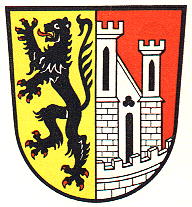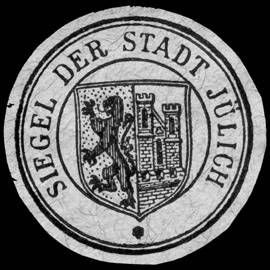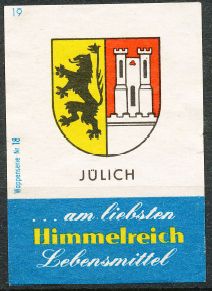Jülich
This page is part of the German heraldry portal Deutsche Wappensammlung |
Heraldry of the World |
|
German heraldry:
|
Selected collector's items from Germany:
|
JÜLICH
State : Nordrhein-Westfalen
District (Kreis) : Düren (until 1971 Jülich)
Additions : 1916 Altenburg, Daubenrath, Selgersdorf ; 1972 Barmen, Bourheim, Broich, Kirchberg, Koslar, Mersch (Jülich), Merzenhausen, Pattern (Jülich), Stetternich, Welldorf (1969 Güsten); 1981 Lich-Steinstraß
| German |
Origin/meaningThe arms were granted on October 8, 1886 and are a combination of the old lion of the counts of Jülich and a part of a fortified town. Jülich became a city in 1238. It was fortified in 1280 and became one of the strongholds of the counts of Jülich. The first seal of the city, dating from around 1300, shows a shield with the lion placed before a castle. Smaller seals of the city only show the lion. The lion was used as arms of the city until this century when the present arms were devised.
The lion of Jülich alone forms part of many civic arms in Germany, like Bad Münstereifel, Bergheim, Brüggen, Dormagen, Eschweiler, Frechen, Gangelt, Geilenkirchen, Grevenbroich, Heimbach, Jüchen, Düren, Kaster, Linnich, Monschau, Nideggen and Nörvenich In 1377 the counts of Gulik inherited the duchy of Gelre (derived from the town of Geldern), making them even more influential, as the duchy was one of the largest independent states of what is now The Netherlands. The lions of Jülich and Gelre were combined. This combination is now the arms of the Dutch province of Gelderland and the former district of Geldern. The combination is also part of the arms of many Dutch communities in the former duchy (like Mook en Middelaar, Linne and Tiel). Contact and SupportPartners: Your logo here ?
© since 1995, Heraldry of the World, Ralf Hartemink Literature : Stadler, 1964-1971, 8 volumes. |
















